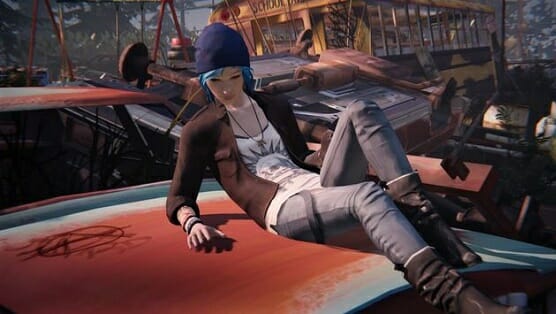Life Is Strange Episode 2: Sophomore Slump

I’m worried about where Life Is Strange is headed.
The second episode of Dontnod Entertainment’s game about a teen who discovers she has time-travel powers may have bitten off more than it could chew. If Life Is Strange were a TV show, I would have removed it from my queue by now—but since it’s a videogame, I don’t have any other options to choose from if I want to experience a story about women (even one created by an all-male team, since that is the deal that the games industry has regretfully struck, at least until they figure out how to hire women).
This episode’s first hour echoes the promise of the first episode; Life Is Strange excels in the small details of environmental storytelling. Max starts her day with a shower and a text from Chloe, the childhood best friend who has rekindled their bond now that Max has moved back to their old hometown. Chloe implores Max not to be “late” to their breakfast date, but just like in Episode One, Max can’t ever be “too late” to anything—not because of her time travel powers, but because of the game’s structure. No matter how long Max spends in the shower eavesdropping on the popular girls, or having a heart-to-heart with her school friend Kate, or absentmindedly strumming the guitar leaned against her bedroom wall, she’ll still beat Chloe to the diner and order a meal with time to spare.
Why instruct the player over and over to “not be late,” then? For a game about time travel, Life Is Strange has a very opaque approach to how much time—and how much power—the player has over what’s happening in the world around them. In this episode, Max learns that if she uses her time travel too often, she’ll get a nosebleed and pass out from exhaustion; this essentially means that Max can use her ability as often as she needs to when the game calls for it, but if the narrative stakes would benefit from Max being unable to use her ability, she’ll suddenly be too tired to save the day in the usual way. There is no charge meter for Max’s ability, nor is there any ticking clock in-game. I understand the lack of these fixtures, since they would add an unnecessarily gamified layer to the tactile, virtual world of Life Is Strange—but the unfortunate result is that Max’s powers seem reliant upon the whims of the narrative.
The narrative takes some particularly thorny turns in Episode 2, and I’m not sure the writers of this game have proven themselves up to the task ahead of them. In Episode 1, Max narrowly saved Chloe from getting shot by Nathan Prescott, a fellow student who deals drugs, throws wild parties, and roofies the girls who attend them. His parents are rich enough to cover up their son’s horrific crimes; when Max tells her principal that Nathan brought a gun to school, the man hardly seems concerned. At the start of Episode 2, Kate tells Max that she believes Nathan tried to drug her at a party and sexually assault her; Chloe told a very similar story at the end of Episode 1. So, Nathan Prescott is a drug dealer, an attempted murderer (or just a straight-up murderer, if Max didn’t have the time travel powers to stop him), and a serial rapist. Honestly, do we need all three of these to prove Nathan’s a real villain? It’s no wonder that the authority figures think Max must be making up stories when she tries to turn this guy in.
The middle of this episode involves a long sequence in a junkyard with Chloe; she tells you to find bottles so that she can practice aiming at them with a gun she stole from her stepdad. Chloe implies that she intends to shoot Nathan with the gun once she gets good enough at practicing. This is around when the game’s mechanics begin to show their seams. Life Is Strange can’t seem to decide whether or not it needs “gamey” elements, like point-and-click puzzles and the absurd sequence in which Max uses her powers to help Chloe aim a gun. How and why would time travel help somebody aim a gun? Well, it doesn’t, and this sequence makes absolutely no sense at all. The junkyard scene includes multiple moments where you have to save Chloe’s life, yet again; playing with a gun is dangerous, plus Chloe has some dangerous friends who live near the junkyard, plus Chloe thinks it’s fun to play on the train tracks even though a train comes every few minutes or so.
